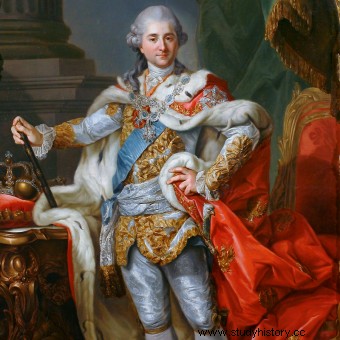
Portrait of the king in a coronation garment by Marcello Bacciarelli.
Stanisław August Poniatowski
The elected king of Poland after the death of August III, the last king of the Polish-Lithuanian Commonwealth. Born January 17, 1732 in Wołczyn. He was the son of an influential but not very wealthy aristocrat, Stanisław Poniatowski. Carefully educated, in 1748 he began his career in a Lithuanian office. He was a member of the Seyms, and from 1755 a Lithuanian carpenter. For several years he stayed in St. Petersburg, first as secretary of an English envoy, and then as a Saxon envoy. He then got into an affair with the wife of the Russian heir to the throne, the future Tsarina Catherine the Great. With her support, he was put forward by the Czartoryski family, whom he served, and on November 25, 1764, he was elected the Polish king. From his accession to the throne, Stanisław August made efforts to strengthen Polish culture. In 1765 he founded the National Theater in Warsaw. In the same year, the journal Monitor, was founded under his patronage and in Warsaw, the Knight School to educate future cadets. He formed the permanent Polish diplomatic service. From around 1770 he organized "Thursday Dinners" . In 1773, co-founder of the National Education Commission.
A patron of the arts and reformer, he made mostly unsuccessful attempts to modernize the Polish political system and to put an end to the reigning powerlessness of the state. On February 24, 1768, the Commonwealth signed a treaty of perpetual friendship with Russia, which made it a Russian protectorate. Catherine II guaranteed the inviolability of the borders and internal system of this state. From 1768 he struggled with the Bar Confederation established by some of the nobility. In 1772, he did not manage to stop the first partition of the country, carried out jointly by Prussia, Austria and Russia. Submitting to violence, he joined the Targowica Confederation.
His project to change the political system became the basis for the May 3 constitution adopted in 1791 during the four-year parliamentary session. A year later, Russian troops entered the country, and in 1793, the second partition of Poland took place. Stanisław August lost real power, and after the outbreak of the Kościuszko Uprising, he became a hostage to the insurgents. On November 25, 1795, at the behest of Tsarina Catherine II, he left Warsaw for Grodno and signed the act of his abdication. He received a lifetime salary from the partitioning powers, all the more necessary as he was considered one of the most indebted monarchs on the continent. The last king of Poland died on February 12, 1798 in St. Petersburg. Currently buried in the Cathedral Basilica of St. John the Baptist in Warsaw.
